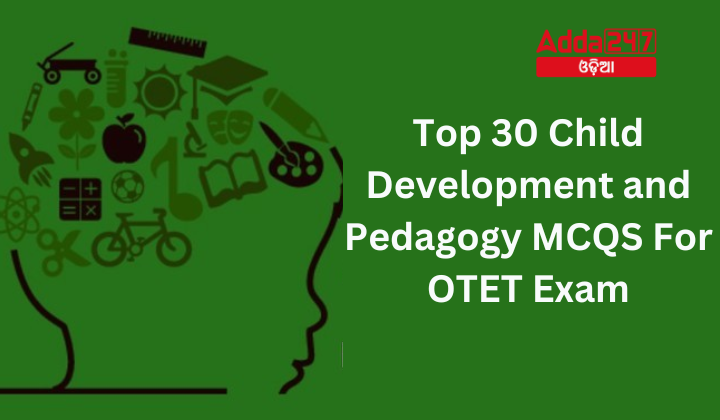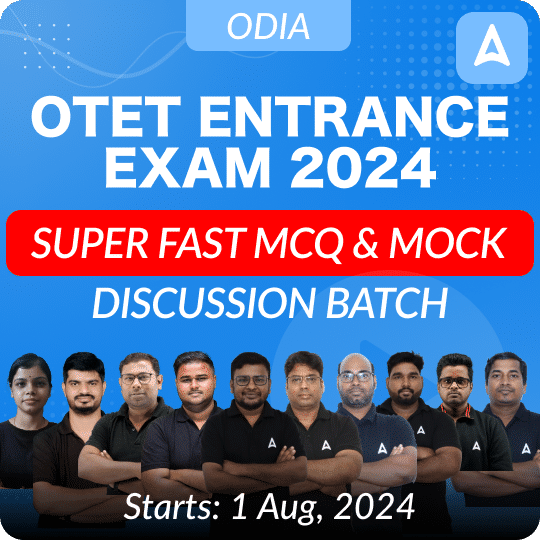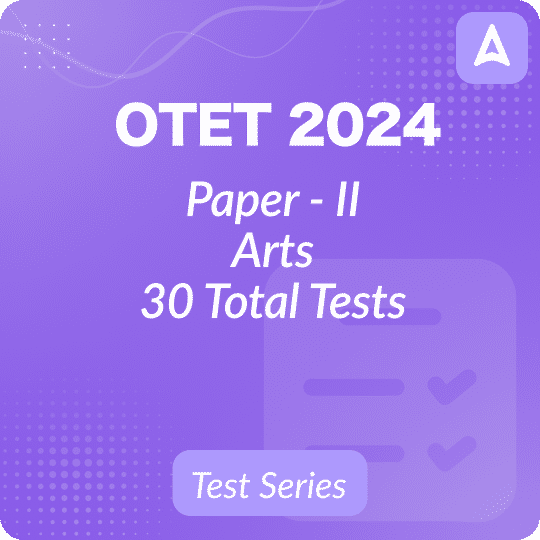The Odisha Teacher Eligibility Test (OTET) assesses the eligibility of candidates to teach in schools of Odisha. A crucial section of this exam is Child Development and Pedagogy, which evaluates understanding of child development and the principles of pedagogy. Below are 30 multiple-choice questions (MCQs) designed to help candidates prepare for this section.
Top 30 Child Development and Pedagogy MCQS For OTET Exam
- Which of the following is considered a primary or physiological need?
(a) Need for security
(b) Need for love
(c) Need for oxygen
(d) Need for approval
Ans: (c) Need for oxygen - What type of need is associated with the socio-cultural environment of an individual?
(a) Physiological needs
(b) Secondary needs
(c) Tertiary needs
(d) Basic needs
Ans: (b) Secondary needs - The need for emotional, social, and economic security in adolescents falls under which category?
(a) Physiological needs
(b) Socio-psychological needs
(c) Basic needs
(d) Self-actualization needs
Ans: (b) Socio-psychological needs - Adolescents’ strong desire to love and be loved is primarily related to which need?
(a) Need for security
(b) Need for freedom
(c) Need for love
(d) Need for self-expression
Ans: (c) Need for love - What is the primary reason adolescents seek approval and recognition?
(a) To satisfy their ego
(b) To express their independence
(c) To fulfill physiological needs
(d) To achieve self-actualization
Ans: (a) To satisfy their ego - Which need reflects an adolescent’s desire to wean away from parental control?
(a) Need for security
(b) Need for love
(c) Need for freedom and independence
(d) Need for self-expression
Ans: (c) Need for freedom and independence - The inherent desire of adolescents to express their potentialities and achieve success is categorized under which need?
(a) Need for security
(b) Need for love
(c) Need for freedom
(d) Need for self-expression and achievement
Ans: (d) Need for self-expression and achievement - The problem of adjusting to somatic variations during adolescence is primarily due to:
(a) Lack of security
(b) Physical changes during puberty
(c) Need for independence
(d) Need for love
Ans: (b) Physical changes during puberty - What leads to the intensification of sex-consciousness in adolescents?
(a) Emotional security
(b) Physical changes during puberty
(c) Curiosity about sex-related topics
(d) Desire for independence
Ans: (c) Curiosity about sex-related topics - Adolescents often experience conflict with parents over:
(a) Physical security
(b) Choice of education and lifestyle
(c) Basic physiological needs
(d) Achievements in school
Ans: (b) Choice of education and lifestyle - According to Garrison, Anderson, & Archer (2000), what are the three interdependent elements in the Community of Inquiry framework?
a) Social, Cognitive, and Emotional Presence
b) Cognitive, Teaching, and Emotional Presence
c) Social, Cognitive, and Teaching Presence
d) Cognitive, Social, and Administrative Presence
Answer: c) Social, Cognitive, and Teaching Presence - What is the primary focus of Teaching Presence according to Anderson, Rourke, Garrison, & Archer (2001)?
a) Facilitating social interactions
b) Designing curriculum
c) Directing cognitive and social processes
d) Assessing student performance
Answer: c) Directing cognitive and social processes - Cognitive Presence is defined as the extent to which learners can:
a) Access resources and materials
b) Interact with peers and instructors
c) Construct and confirm meaning through sustained reflection and discourse
d) Complete assignments on time
Answer: c) Construct and confirm meaning through sustained reflection and discourse - Social Presence is described as the ability of participants to:
a) Master technical skills
b) Identify with the community and communicate purposefully
c) Focus solely on academic content
d) Maintain high grades
Answer: b) Identify with the community and communicate purposefully - Which element of the Community of Inquiry framework involves the development of inter-personal relationships and projecting individual personalities?
a) Cognitive Presence
b) Teaching Presence
c) Social Presence
d) Emotional Presence
Answer: c) Social Presence - What does the Community of Inquiry framework suggest is necessary to sustain an educational experience over time?
a) Frequent assessments
b) High levels of cognitive presence
c) A sense of belonging to a community on both cognitive and social levels
d) Strict adherence to course deadlines
Answer: c) A sense of belonging to a community on both cognitive and social levels - How can instructors help students feel free to experiment with concepts covered in class?
a) By providing more lecture time
b) By focusing solely on theoretical content
c) By creating an environment where students are willing to take risks and learn from mistakes
d) By limiting class discussions to course content only
Answer: c) By creating an environment where students are willing to take risks and learn from mistakes - What can instructors do to make the course content personally meaningful to students?
a) Assign more reading materials
b) Allow students to share their past experiences and relate them to current course topics
c) Increase the number of tests
d) Limit student interactions to formal settings
Answer: b) Allow students to share their past experiences and relate them to current course topics - What is one way to build a sense of community in a classroom?
a) Enforcing strict rules
b) Allowing students to vent about personal issues at the beginning of class
c) Limiting interactions to academic discussions
d) Avoiding personal conversations
Answer: b) Allowing students to vent about personal issues at the beginning of class - What initiative is mentioned as a way to help undergraduate students get to know professors at uWaterloo?
a) Online forums
b) Peer tutoring sessions
c) FEDS Eat & Speak Mentorship Series
d) Study groups
Answer: c) FEDS Eat & Speak Mentorship Series - What is test-retest reliability?
(a) The consistency of scores across different items within a measure
(b) The consistency of scores across different observers
(c) The consistency of scores across time
(d) The extent to which a measure covers the entire construct
Answer: (c) The consistency of scores across time - How is test-retest reliability typically assessed?
(a) By computing Cronbach’s α
(b) By splitting items into two sets and correlating scores
(c) By graphing data in a scatterplot and computing Pearson’s r
(d) By comparing scores across different observers
Answer: (c) By graphing data in a scatterplot and computing Pearson’s r - Which of the following would indicate good test-retest reliability?
(a) A Pearson’s r value of +.60
(b) A Pearson’s r value of +.70
(c) A Pearson’s r value of +.80 or greater
(d) A Pearson’s r value of +.90 or less
Answer: (c) A Pearson’s r value of +.80 or greater - What is internal consistency in the context of psychological measures?
(a) The consistency of scores across time
(b) The consistency of scores across different raters
(c) The correlation between scores on different items of the same measure
(d) The extent to which a measure covers all aspects of the construct
Answer: (c) The correlation between scores on different items of the same measure - How is internal consistency most commonly assessed?
(a) By computing Pearson’s r between test-retest scores
(b) By using Cronbach’s α
(c) By comparing scores across different observers
(d) By evaluating face validity
Answer: (b) By using Cronbach’s α - What does a split-half correlation measure?
(a) The consistency of scores over different time points
(b) The relationship between scores on even-numbered and odd-numbered items
(c) The correlation between scores on different measures of the same construct
(d) The agreement between different rater
Answer: (b) The relationship between scores on even-numbered and odd-numbered items - What is interrater reliability?
(a) The extent to which a measure correlates with other variables
(b) The extent to which different observers are consistent in their judgments
(c) The consistency of scores across different items in a measure
(d) The extent to which a measure covers the entire construct
Answer: (b) The extent to which different observers are consistent in their judgments - Which statistic is commonly used to assess interrater reliability for categorical judgments?
(a) Pearson’s r
(b) Cronbach’s α
(c) Cohen’s κ
(d) Split-half correlation
Answer: (c) Cohen’s κ - What does face validity refer to?
(a) The extent to which a measure correlates with other relevant variables
(b) The extent to which a measure appears to measure what it is supposed to measure
(c) The consistency of responses across different items of a measure
(d) The coverage of all aspects of a construct by a measure
Answer: (b) The extent to which a measure appears to measure what it is supposed to measure - What is criterion validity?
(a) The extent to which scores on a measure are not correlated with conceptually distinct variables
(b) The extent to which a measure covers all aspects of the construct
(c) The extent to which scores on a measure correlate with other relevant variables
(d) The extent to which a measure’s items reflect the construct being measured
Answer: (c) The extent to which scores on a measure correlate with other relevant variables










